Opening Day
The whole Mendenhall Building was bustling when we arrived about 9:15 on Saturday 22 May (after an utterly sleepless night). Michael went upstairs immediately to turn on the museum’s electronic displays and ensure that they booted up—his usual daily task—but didn’t have time to check the new kiosks because Elder Y from the Pacific Area presidency wanted to meet with us and Elder and Sister E right away. The subject of the meeting was to discuss future directions for the Matthew Cowley Pacific Church History Centre now that the Sacrifice and Consecration exhibit had reached completion. (No rest for the weary!)

Greeters: Nancy, Kara, Wendy, and Jo-Ena
We spent the remainder of the morning helping the Church Communications and Publishing Services crews set up their recording equipment and identify the people they should interview during the event. At noon, Nancy shut down the museum after ensuring that no one was left inside. There had not been as many visitors as anticipated because it turned out that the daytime sessions of the Young Single Adult Conference planned for Saturday were athletic activities held elsewhere, which relieved congestion not only in the building but also in the carpark. Nancy ducked out to the car for a few minutes to eat the cheese and raw veggies she had brought to tide her over until teatime. When she returned to the Centre, the guests had begun to arrive.

Helena helps a guest with her name tag
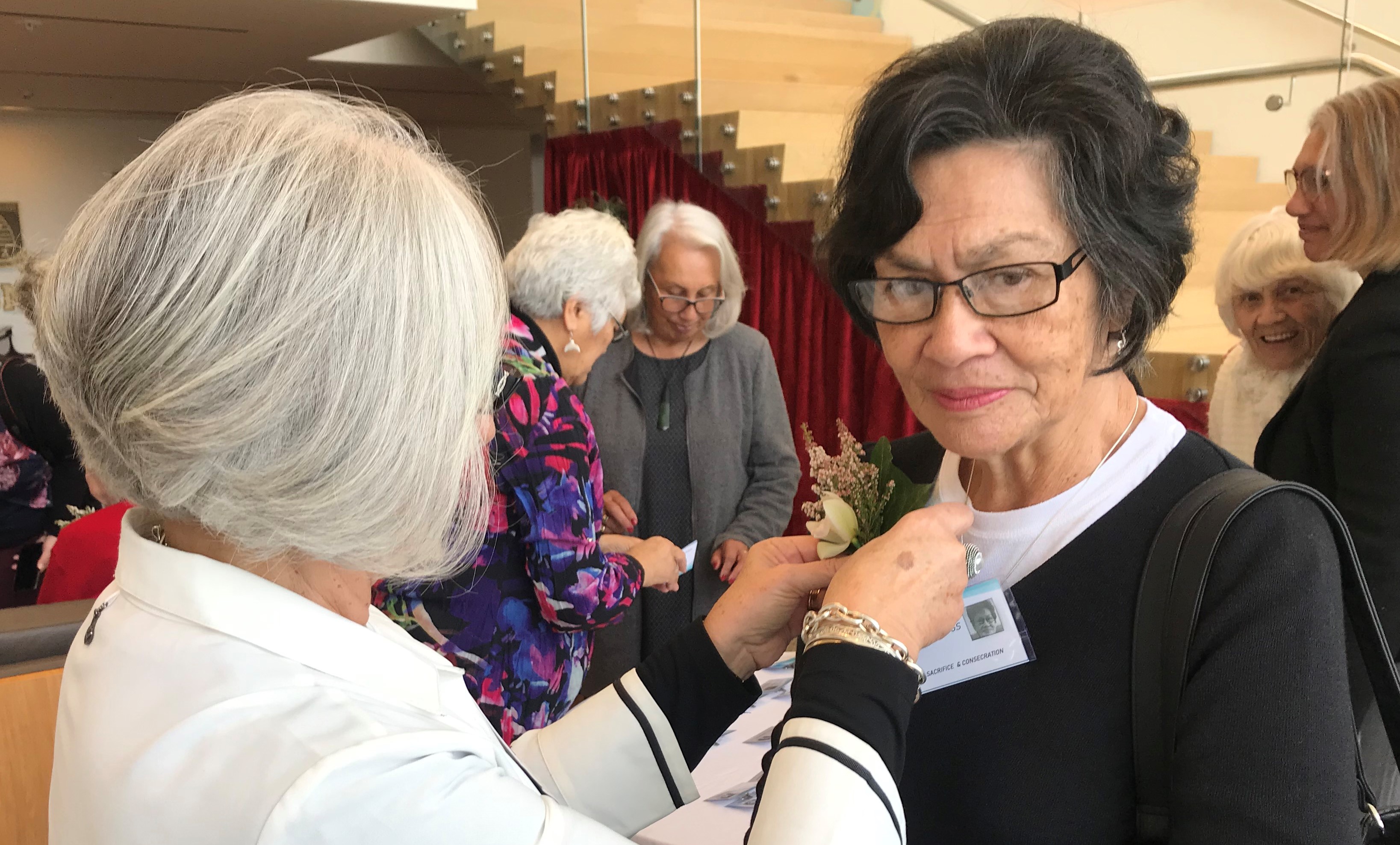
Marilyn pins a simple corsage on Lynda, who served in the “second wave” of the labor missionary program
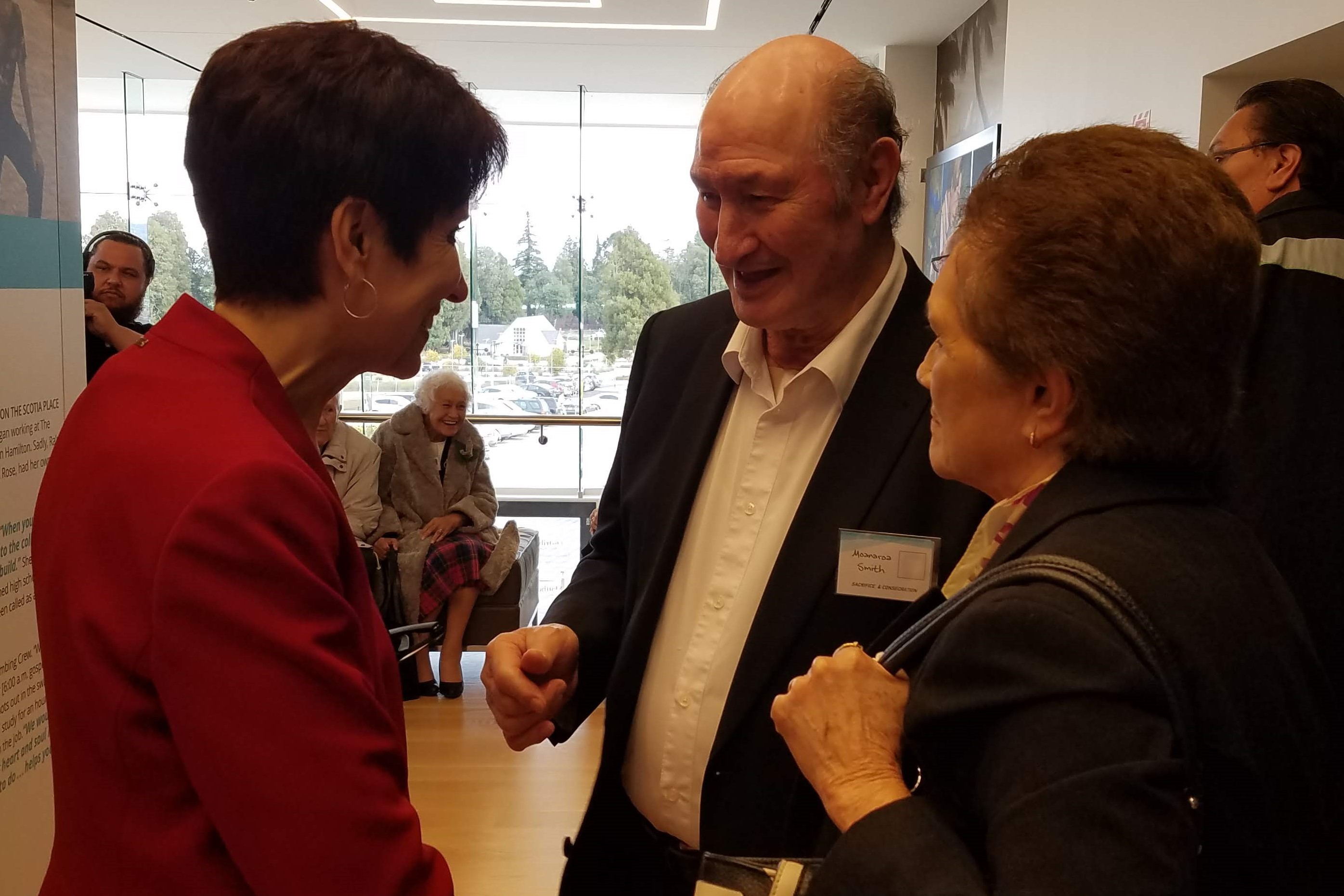
Eva chats with Mo, a former labor missionary, and his wife Maeva; Mo and Maeva also serve as volunteer museum guides
Sister E had assigned Nancy, Wendy, and Kara to greet entering guests and help them find their name tags. Wendy and Kara had known many of these people from childhood, renewing old acquaintances at periodic labor missionary reunions over the years. Although Nancy had not met many of the labor missionaries in the flesh, their faces had become so familiar during her months of research that it wasn’t hard for her to recognize them as they came through the door.

At age 100, Mere is the oldest surviving labor missionary; she and her escort, Karla, are both members of our ward
Virginia, a paragon of diplomatic firmness, had been designated as the “bouncer” in case anyone who had not been invited tried to get in—not that we were eager to turn people away, but because space in the theatre was limited and priority had to be given to our honored guests. Marilyn and Helena, another regular volunteer, helped Jo-Ena pin flowers on the ladies. (Michael and Nancy were incredulous when we learned that Paula had stayed up most of the night creating a few dozen corsages as well as floral centerpieces for the tables. She had actually gone into the bush after dark with a flashlight to gather the greenery she needed, demonstrating a level of dedication worthy of the labor missionaries themselves.) Melanie, the Church History Department’s Pacific Area manager, and Vicki-Lee, director of Church Communications for Hamilton, escorted distinguished guests such as the local member of Parliament and kaumatua and kuia (elders, male and female) from the area’s Māori iwi (tribes) to their seats at the front of the theatre.
Where was Michael during the hour that the guests were arriving? No one had given him a specific assignment beyond running the videos during the welcome program, so he sequestered himself in the projection room at the back of the theatre where he wouldn’t be in anyone’s way.

Choir singing during the opening program in the theatre
By 1:30, when the welcome program began, the theatre was crammed with over a hundred people, but few seemed to mind the crush—although the choir had to move back and forth from the lower lobby when it was time for them to sing because there was hardly room for them to stand in the theatre, let alone sit.

Aunty Wai shares some thoughts on the exhibit
The first speakers after the ceremonial welcome, prayer, and waiata were Elder and Sister G, who described the genesis of the Sacrifice and Consecration exhibit and why they felt it was important to retell the story. Next came Aunty Wai, one of the first labor missionaries to serve at The Project. Frail but still in possession of all her mental faculties at age 91, she shared her experiences with grace and humor, adding her testimony that working together on The Project had truly brought everyone closer to one another and to the Lord. (Learn more about what Wai shared in this Church News article about the exhibit.) When she was finished, Michael ran two videos: the photo montage of the temple from groundbreaking to dedication, and the Sacrifice and Consecration exhibit preview (tearjerkers, both). Elder Y then expressed appreciation for the labor missionaries who consecrated their time to build the temple, and exhorted us to use the time while the building is being renovated to remodel ourselves after the pattern of the Savior. The choir and congregation both sang, then after the closing prayer everyone began moving into the gallery for the unveiling and ribbon-cutting.

Veiling entire walls was impractical, so Jo-Ena and Diane draped the displays with red ribbons

The display case stands duly veiled

Barry and Eva G remove one of the ribbons

Former labor missionaries Peti and Hoki look for familiar faces; Peti is also one of our volunteer guides; Hoki and her husband chair the New Zealand Labour Missionary Association
With so many people crowding the gallery, it was difficult to read the stories on the walls and impossible to hear any of the recorded interviews playing on the kiosk; nevertheless, visitors were enthralled by the images—and by the spirit generated by the whole experience. For Michael and Nancy, it was tremendously rewarding to meet and talk with people whose stories we had read and whose more-youthful images we had been looking at for months, and to be able to express gratitude for their examples of dedication and faith. At first, we were hesitant to approach people we recognized but who had no idea who we were, but as soon as we introduced ourselves, these humble labor missionaries reached out and pulled us into warm embraces. Many thanked us for bringing their community together again, and for sharing the story of their mutual experience with a new generation.
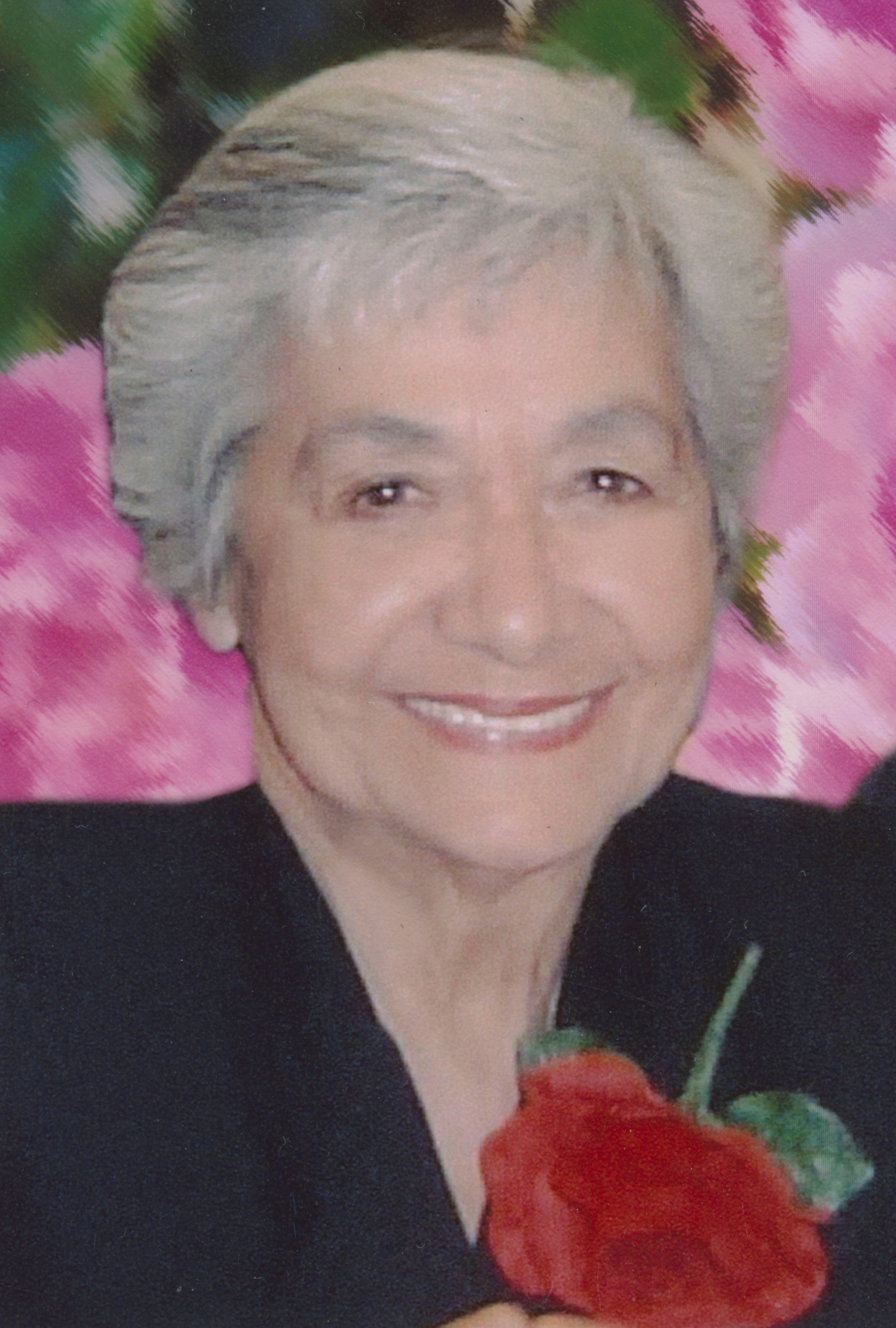
Aunty Manu
It was particularly gratifying for Nancy to receive a hug from Aunty Manu, who had been one of The Project’s best vocalists and later a professional performing partner of Rangi’s. Petite and still stylish at age 80-something, Manu also had recorded one of the most moving statements about the labor missionaries’ building project captured on video:
“This was our parents’ dream, our grandparents’ dream, our great-grandparents’ dream: to have our own chapels, our own school, and our own temple. To become part of this programme, to help this dream become a reality for us all, was just such a privilege and a blessing in our lives. This was His work, and we were grateful to be a part of it. As the buildings were built, so were the people who built them. Young boys developed into fine young men, learning trades as they served which would later serve them in taking care of future families. Young married couples lived the principle of sacrifice and caring for each other. But the greatest thing that I think that we learned was love: love for the Saviour, and love for each other. … It changed my life and made me a better person. Because this programme not only built buildings, we found out, but it built people, good people.”
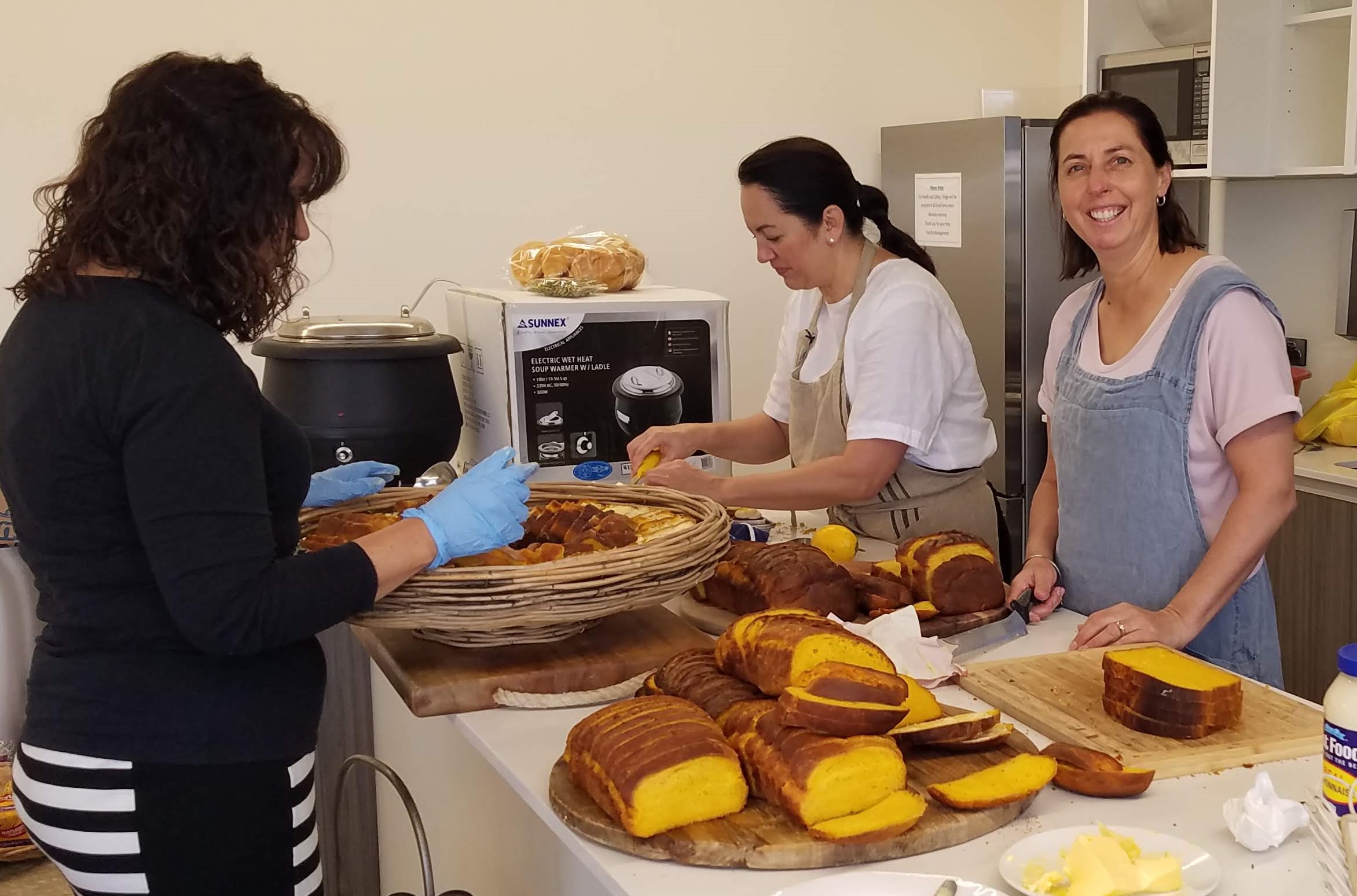
Volunteers preparing for the tea
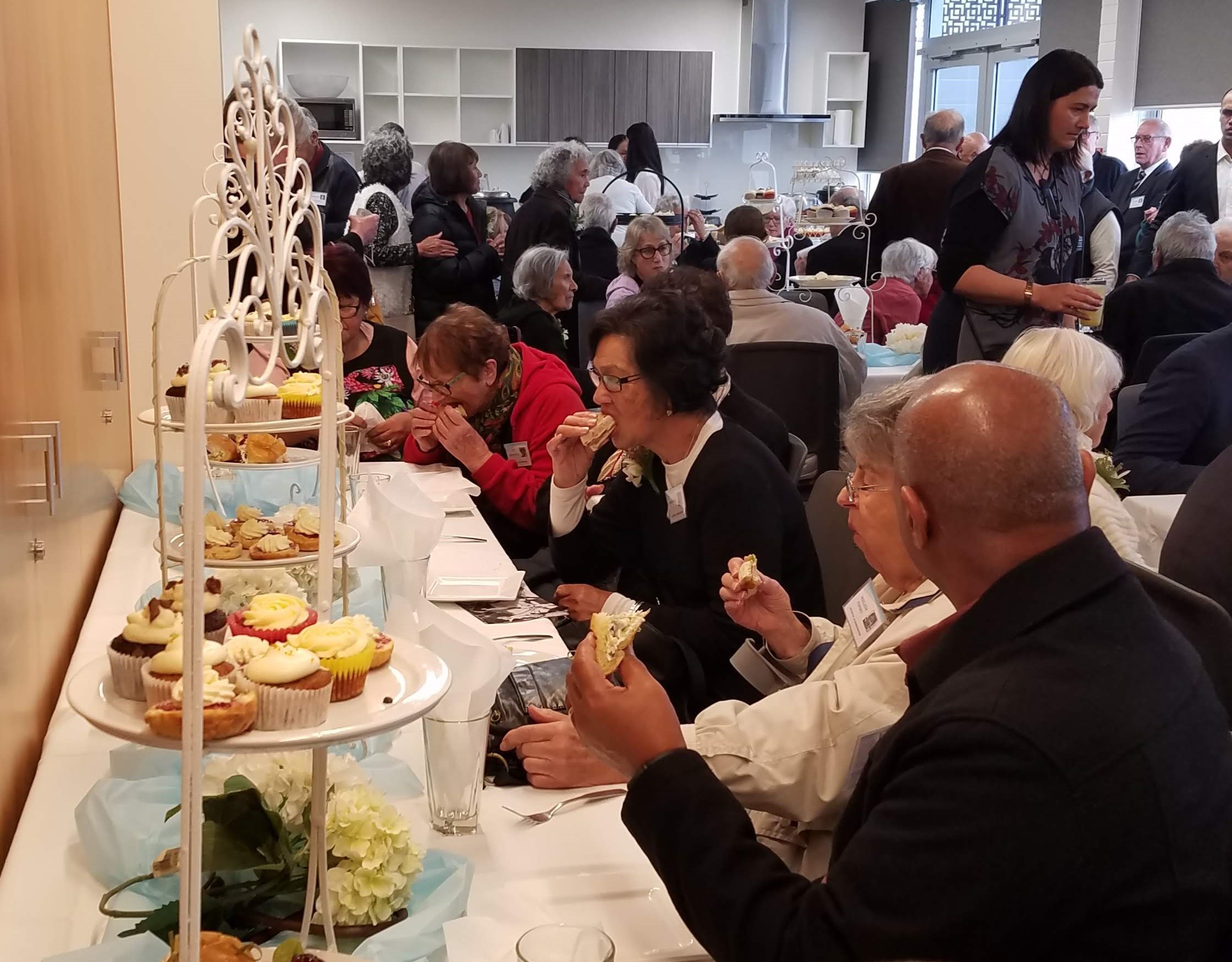
Guests comfortably crowd into the staff lunchroom, transformed for “high tea”
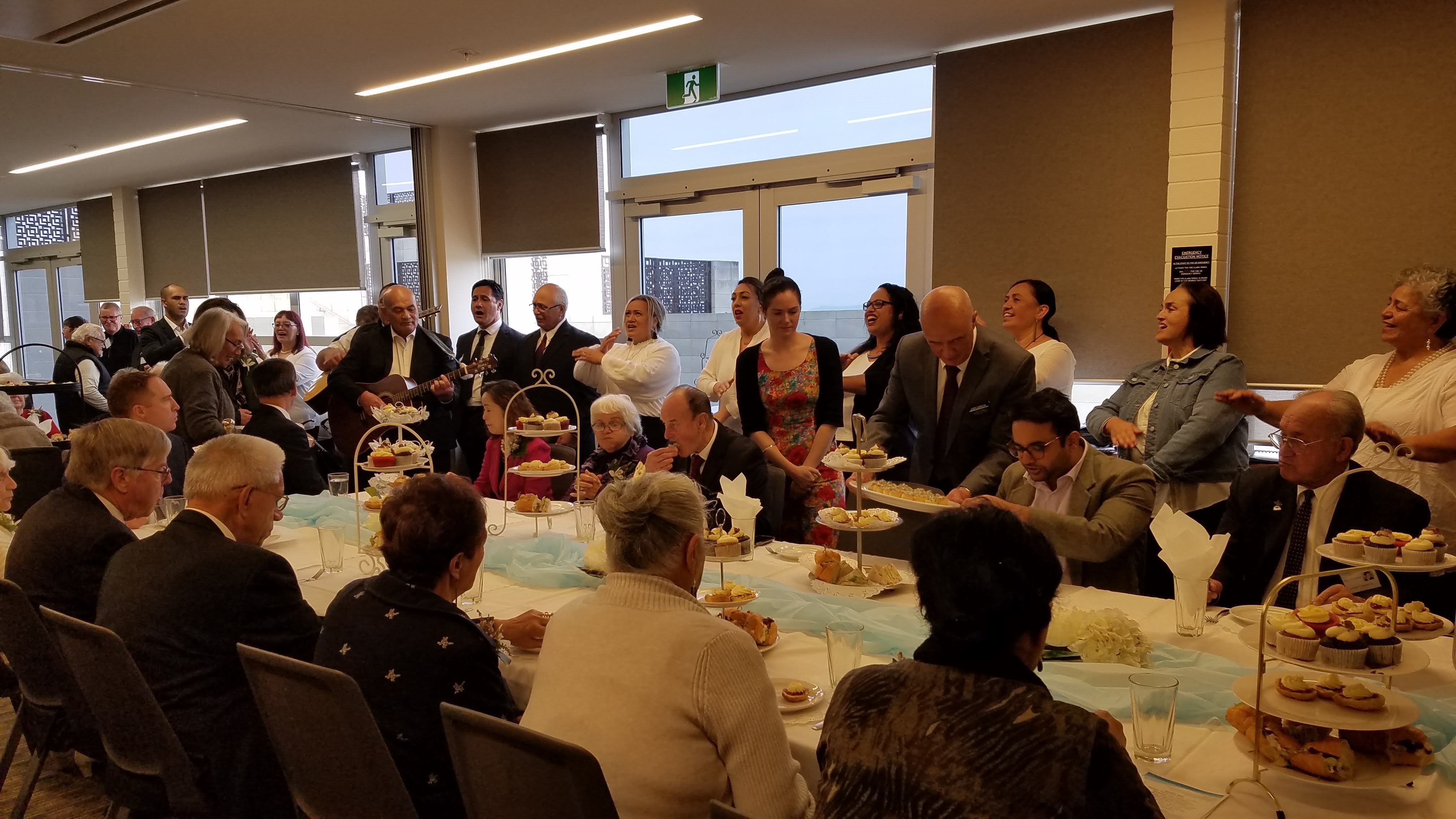
The Temple View kapa haka group performs for the guests
Soon—because everyone was hungry—the assembly made its way downstairs to the lunch room/conference room, which Jo-Ena, Paula, and their assistants had transformed into an elegant tearoom almost capable of accommodating as many people as wanted to squeeze in. Guests thronged in the hallway, where cheerful young people circulated with pitchers of lemonade and trays of egg salad sandwiches. Others spread onto the adjacent outdoor patio, where the weather was chilly but at least not wet. Incredibly, a 20-member kapa haka group managed to wedge themselves into the narrow aisle between a row of tables and the windows and actually perform while guests sipped soup and nibbled on scones topped with raspberry jam and cream. The room was filled with music and happy chatter for the remainder of the afternoon.
As the festivities wound down and the guests began to depart, Michael and Nancy (grateful that we hadn’t been assigned to the clean-up committee) assisted the Church Communications and Publishing Services crews who were still recording interviews with selected attendees. When they quit for the day, Jeff, Kara, Barry, and Eva invited us to join them for a night on the town, but we were so exhausted that all we wanted to do was go home and “get horizontal” (as Nancy’s grandmother used to say). Unfortunately, Nancy still had work to do: Veronica, the Church’s Pacific Area social media coordinator, had asked her to prepare a “historically accurate” post about the labor missionaries and the exhibit opening, and she wanted it done by the next morning. So Nancy spent the evening pecking at her laptop while Michael watched a movie on his. (From a collection of DVDs we had borrowed from the mission president’s wife, he chose Roman Holiday—not what Nancy would have expected him to select, but apparently just the thing to carry him away from the cares of the day.) Nancy finished her writing assignment about the same time Audrey Hepburn and Gregory Peck were saying a wistful goodbye on the movie screen. By 10:00, she and Michael were in bed and sound asleep.
Those preparing food, setting up, and decorating for the next day’s activities were not so fortunate, no doubt working long into the night. They did get some extra help, however. The Young Single Adult conference going on that weekend included a “drive-in movie,” which was held after dark in the carpark between Legacy Park and the David O. McKay Stake and Event Centre. Several of the YSAs who attended were conscripted to set up tables and chairs in the Kai Hall and unload food for the next day’s labor missionary lunch.
Sabbath Service
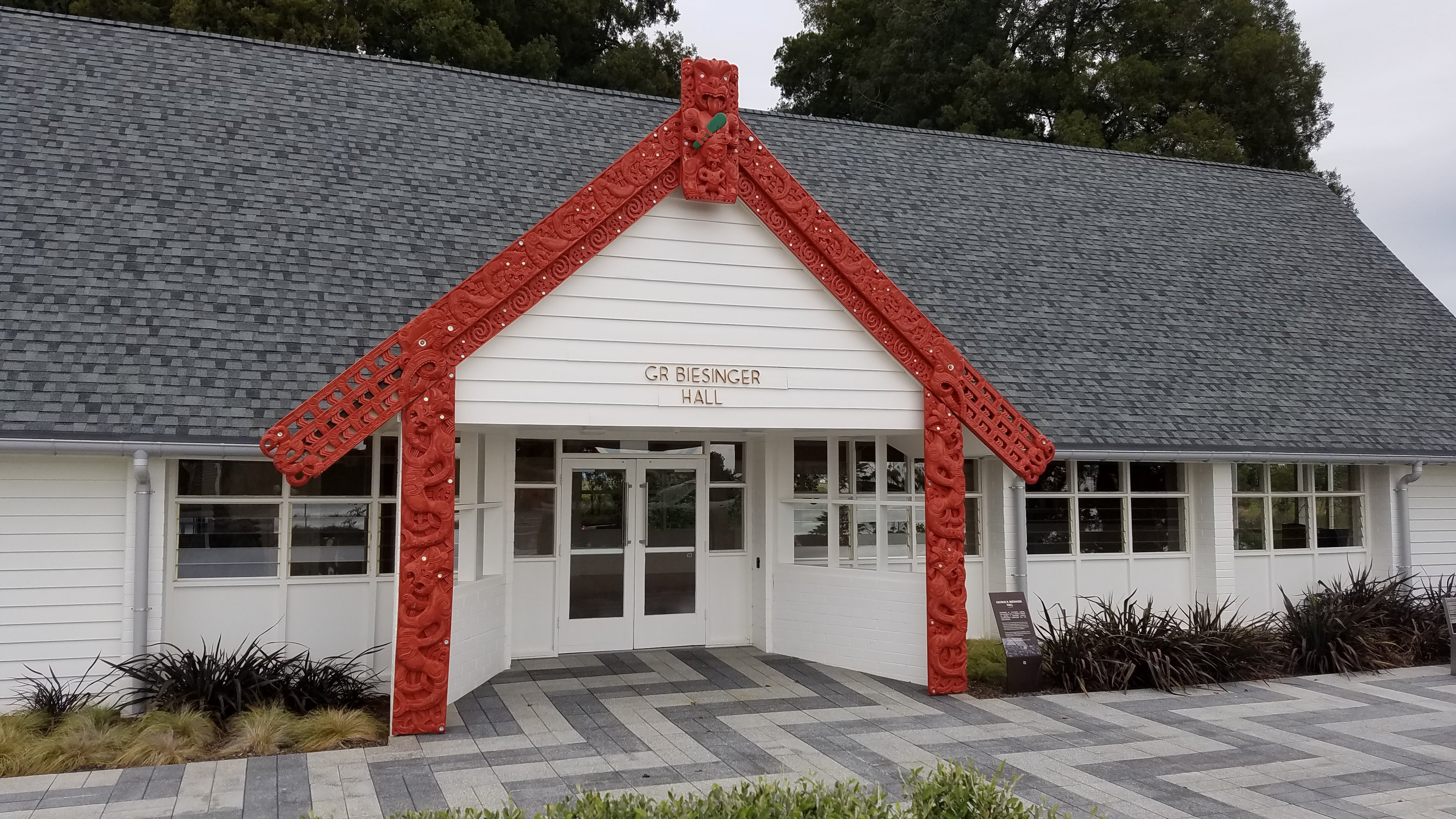
The George R. Biesinger Hall
It was good that at least a few of us got a decent night’s sleep, because this Sabbath did not promise to be very restful. It began fairly easily for Michael and Nancy because, having been delegated no responsibilities for the sacrament service and devotional, we could simply show up at the George R. Biesinger Hall. This historic community center in Legacy Park was erected in 1960 by the labor missionaries in honor of The Project’s beloved construction supervisor. With the college and temple completed and work on meetinghouses elsewhere in New Zealand under control, Church administrators decided to send Elder B to Europe to establish a labor missionary program to build chapels there. Anticipating his four-week absence, the volunteer laborers in Hamilton secretly petitioned Church leaders for permission to build another facility on the CCNZ campus to show their appreciation for Elder B and to serve as a social center for the Temple View community. Permission was granted, plans were drafted, donations were solicited from local families and businesses, and the volunteers went to work as soon as Elder B left for Europe. Because construction on the chapels was still expected to stay on schedule, they worked on the GRB Hall every morning from 5-7 a.m. and then from 5-10 p.m. every night in addition to their regular eight-hour shifts on some other project, finishing in 27 days so the gift would be ready to present to Elder B as soon as he returned. (He was totally surprised!) The GRB was completely renovated in 2017 and continues to serve as a venue for weddings and other social events. Although it was built especially for Elder B, the memorial hall now honors all the labor missionaries, whose names are engraved on brass plaques that cover the wall at one end of the building.
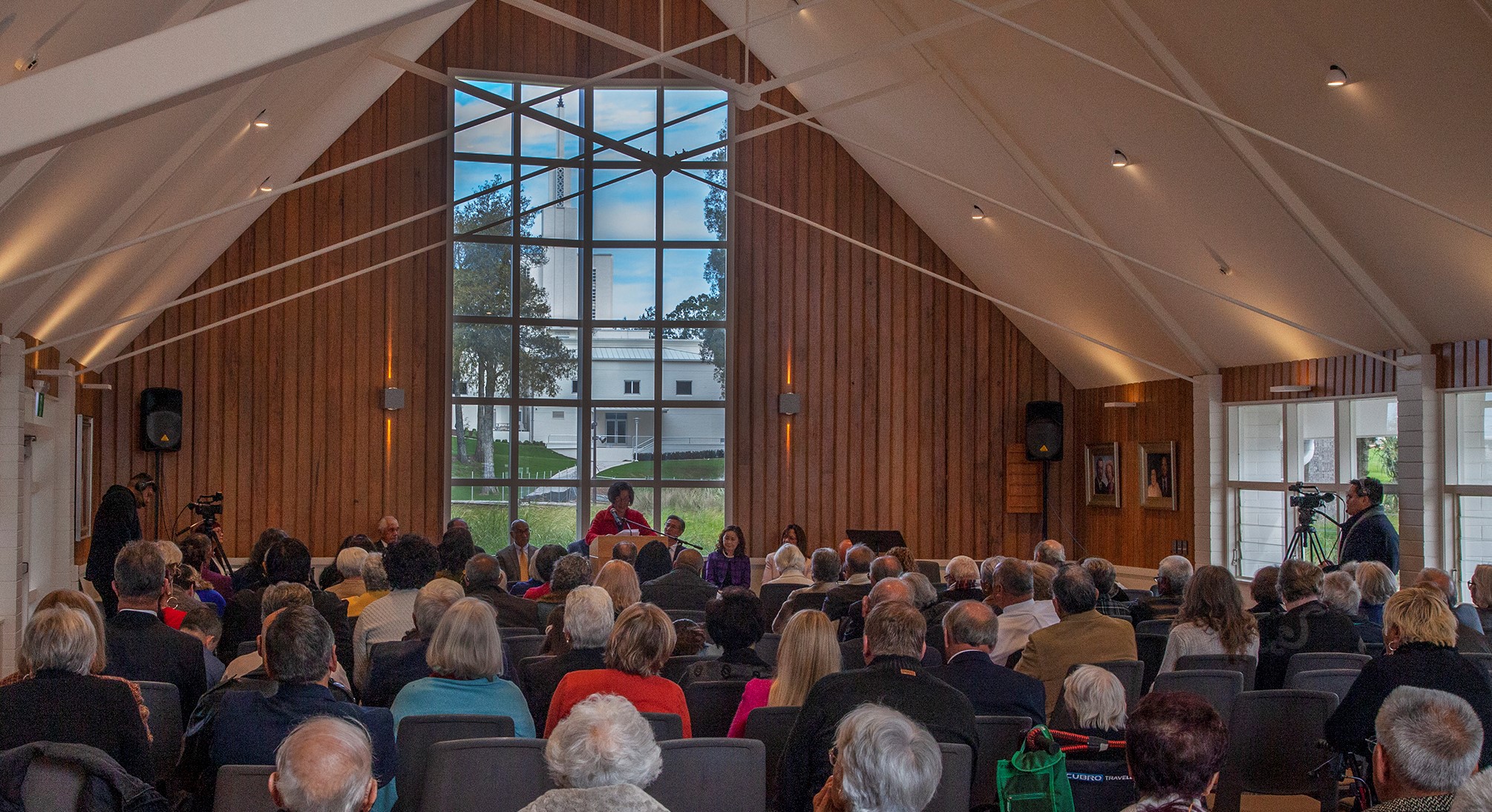
Inside the GRB Hall during the devotional portion of the Sunday morning program
At least as many people attended the sacrament service and devotional as had attended the previous day’s events, with family members of labor missionaries replacing the non-Latter-day Saint dignitaries who had been invited to the exhibit opening. The Māori opening hymn that Michael had so carefully transcribed, “Koutou Katoa Rā,” turned out to be the te reo version of “Come to the Saviour,” an anthem as well known to Christian congregations in New Zealand as “God Save the Queen.” The labor missionary group sang it with fervor, and we were able to sing along because Latter-day Saints use the same tune for “Hark, All Ye Nations.” During the meeting, Elder Y and his wife gave talks focusing on what we can learn from the histories of faithful people who loved God, but for us the most moving part of the service was watching the aged priesthood holders who had been asked to administer the sacrament. It was obviously painful for these former labor missionaries to kneel as they offered prayers over the bread and water, and we were grateful for their willingness to render yet another selfless service to congregants who wanted to renew their commitment to Christ.
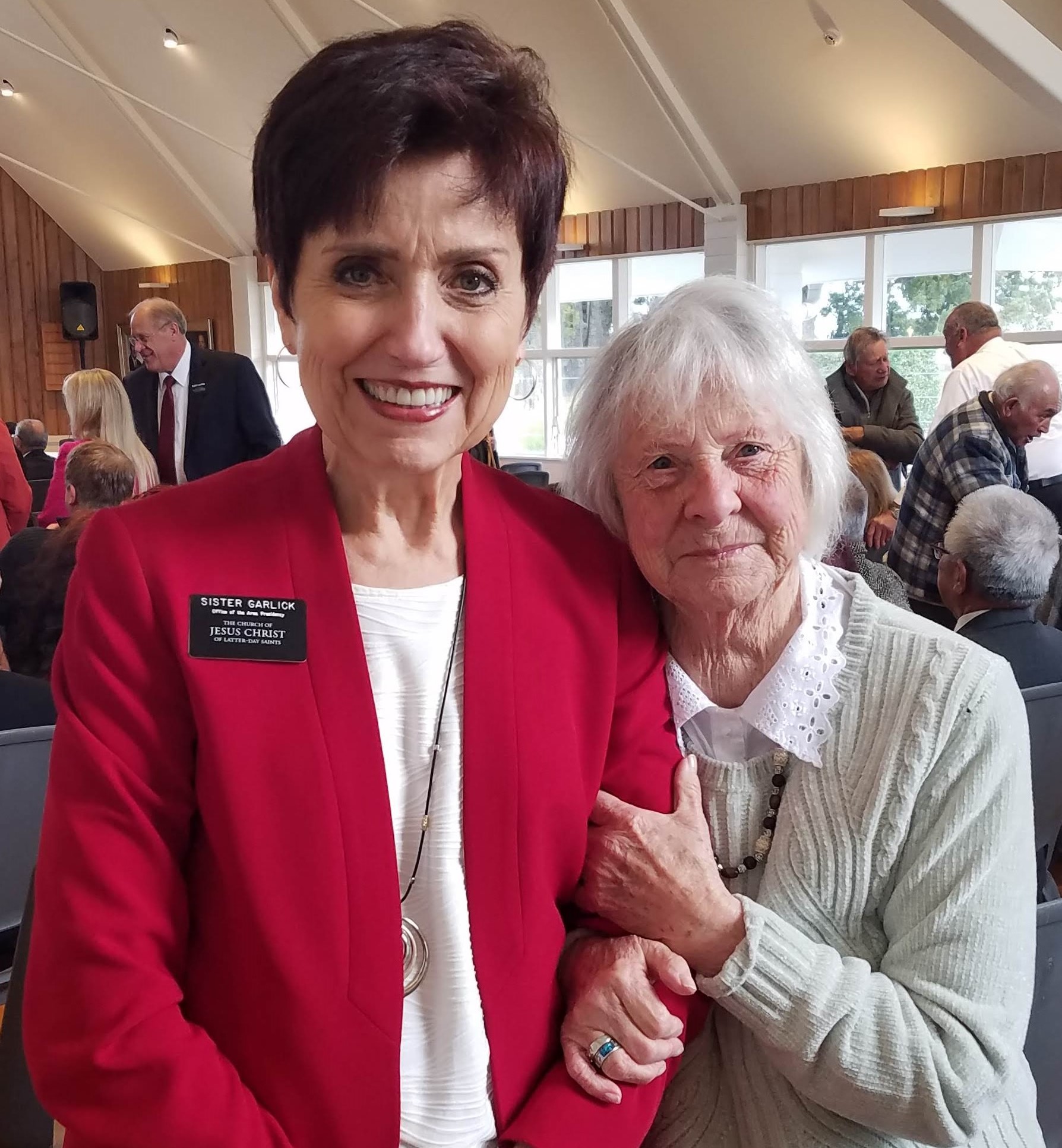
Eva and Daphne during the break
After the sacrament meeting was brought to a close, the congregation was invited to take a five-minute “breather” before the devotional, but everyone was so eager to visit with one another that it was at least another twenty minutes before the second portion of the meeting could begin. It featured a few musical items and talks by former labor missionaries. Notable among the latter was Lynda, who had been part of the “second wave” of labor missionaries called to build chapels after the college and temple were completed. She explained that seeing her parents and others willingly sacrifice to build and then serve at the temple founded her own testimony of the importance of temple covenants, and motivated her to serve her own labor mission. Lynda had recently returned from another mission, serving in Fiji until COVID necessitated a reassignment to Auckland.
Before Elder Y offered his closing remarks, he invited Elder E, Wendy, and Wendy’s older brother George to bear their testimonies. George is named after his father, Elder B, and had spent his adolescent years living in the construction camp along with the other labor missionary families, so he had a unique perspective to share. He and his wife are currently serving a full-time mission in Wellington and were grateful that their mission president allowed them to come to Hamilton for this special occasion.
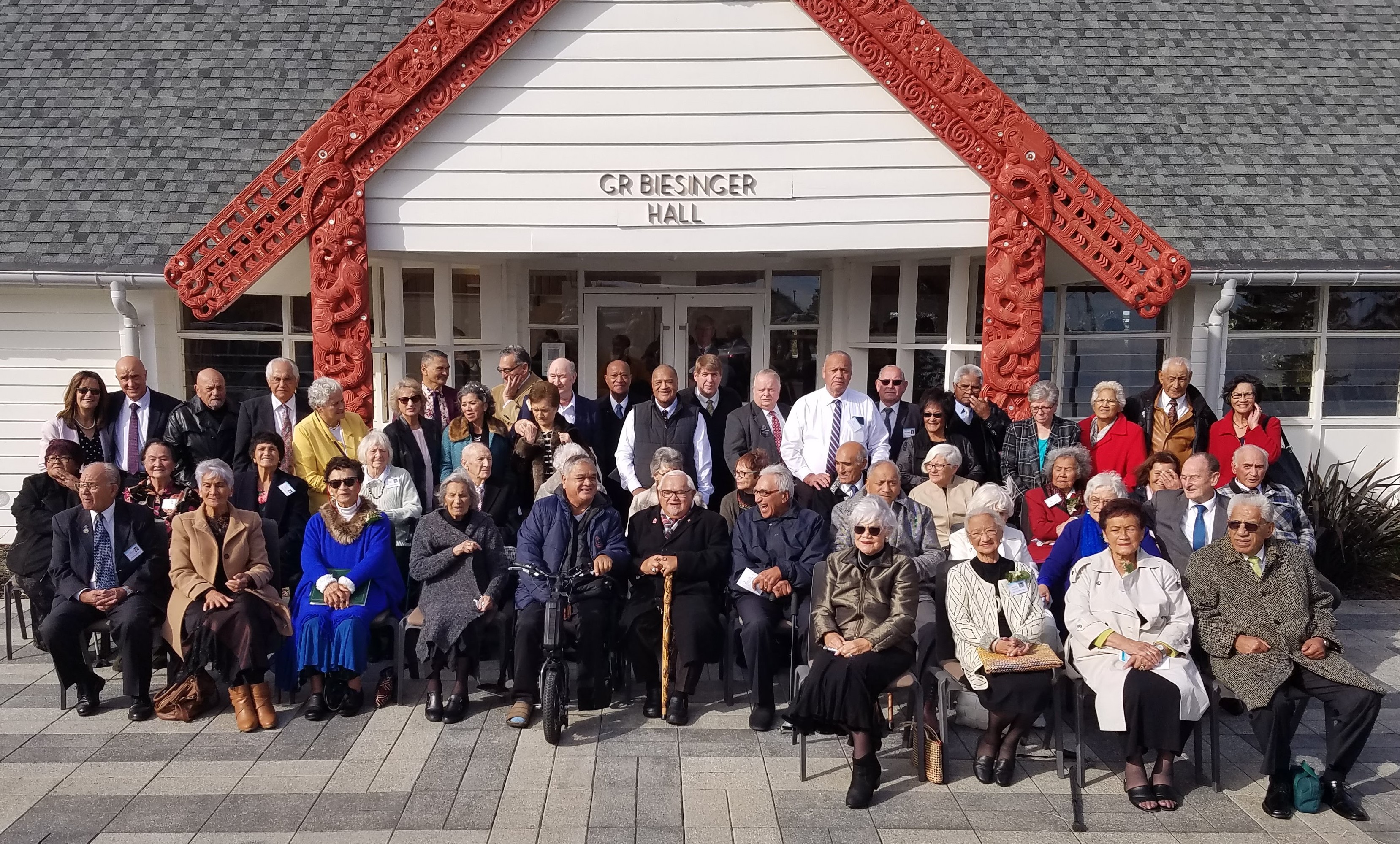
The labor missionaries gathered for a group photo
The devotional ended on a lighthearted note. It had been announced that the closing hymn would be “We Thank Thee, O God, for a Prophet,” whose words were printed in the program, but the pianist—the 82-year-old widow of a labor missionary—got mixed up and began to play “Come, Come Ye Saints” instead. No one was quite sure what to do when the chorister went ahead and began to direct; some of us started in on “Come, Come Ye Saints” while others searched their programs in vain for the right words. Finally President H, who was conducting the meeting, went to the microphone and announced, “We’ll sing ‘We Thank Thee, O God, for a Prophet,’ because those are the words we have.” While the pianist readjusted, Elder Y quipped, “No worries—all is well, all is well!”
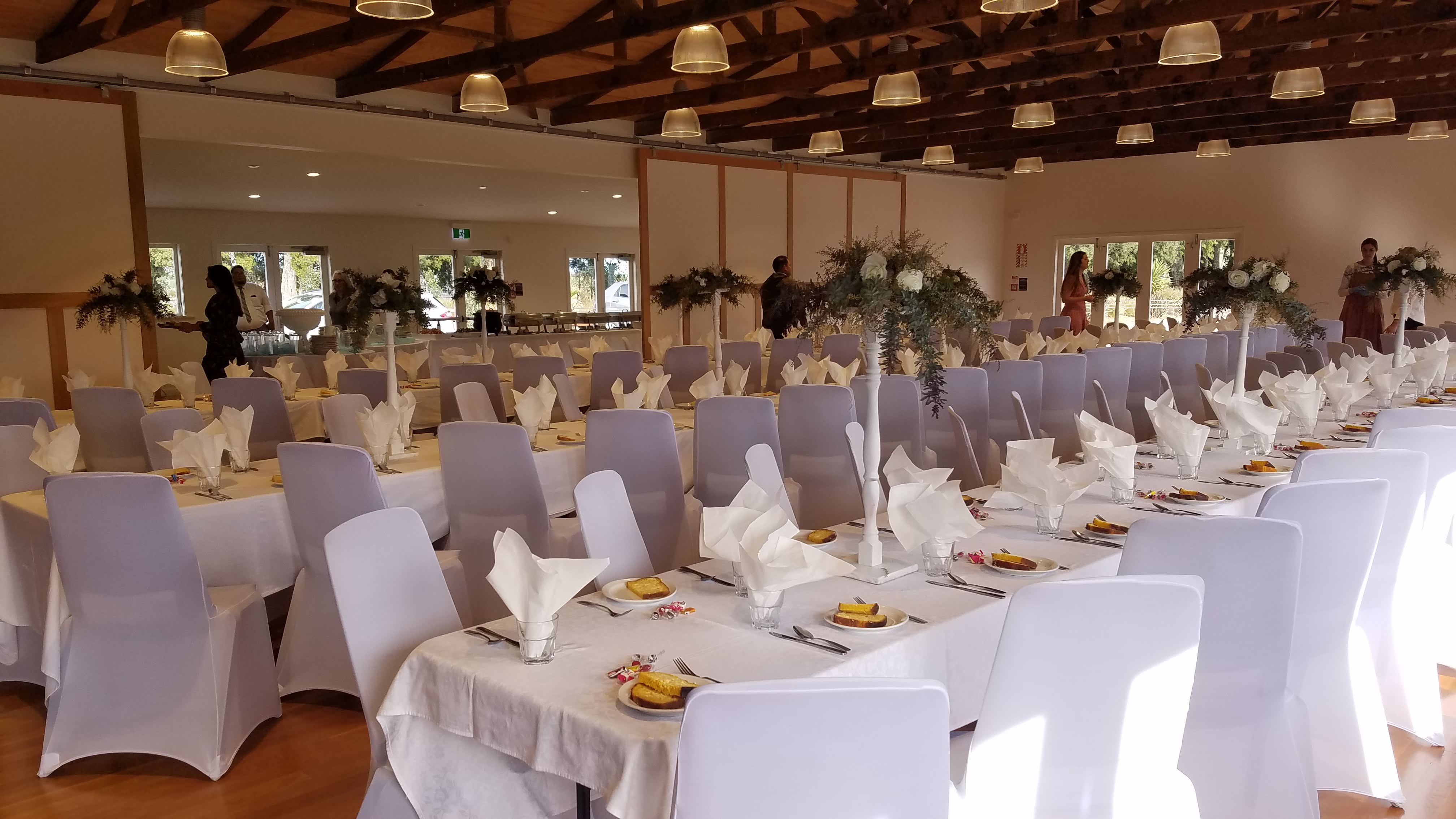
When Melanie surveyed the setup in the Kai Hall, she said, “This is even nicer than my wedding!”
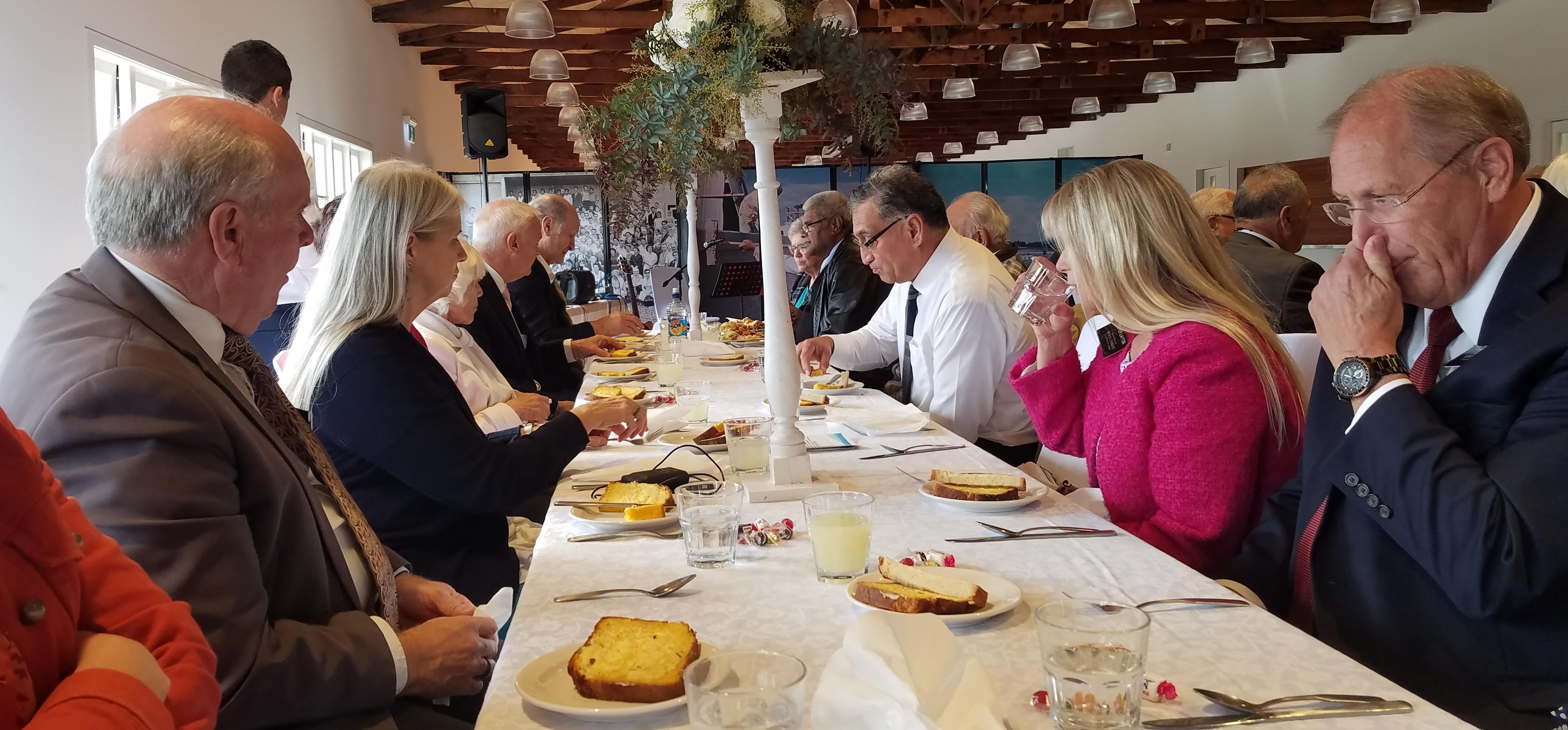
Senior missionaries wait for lunch to be served
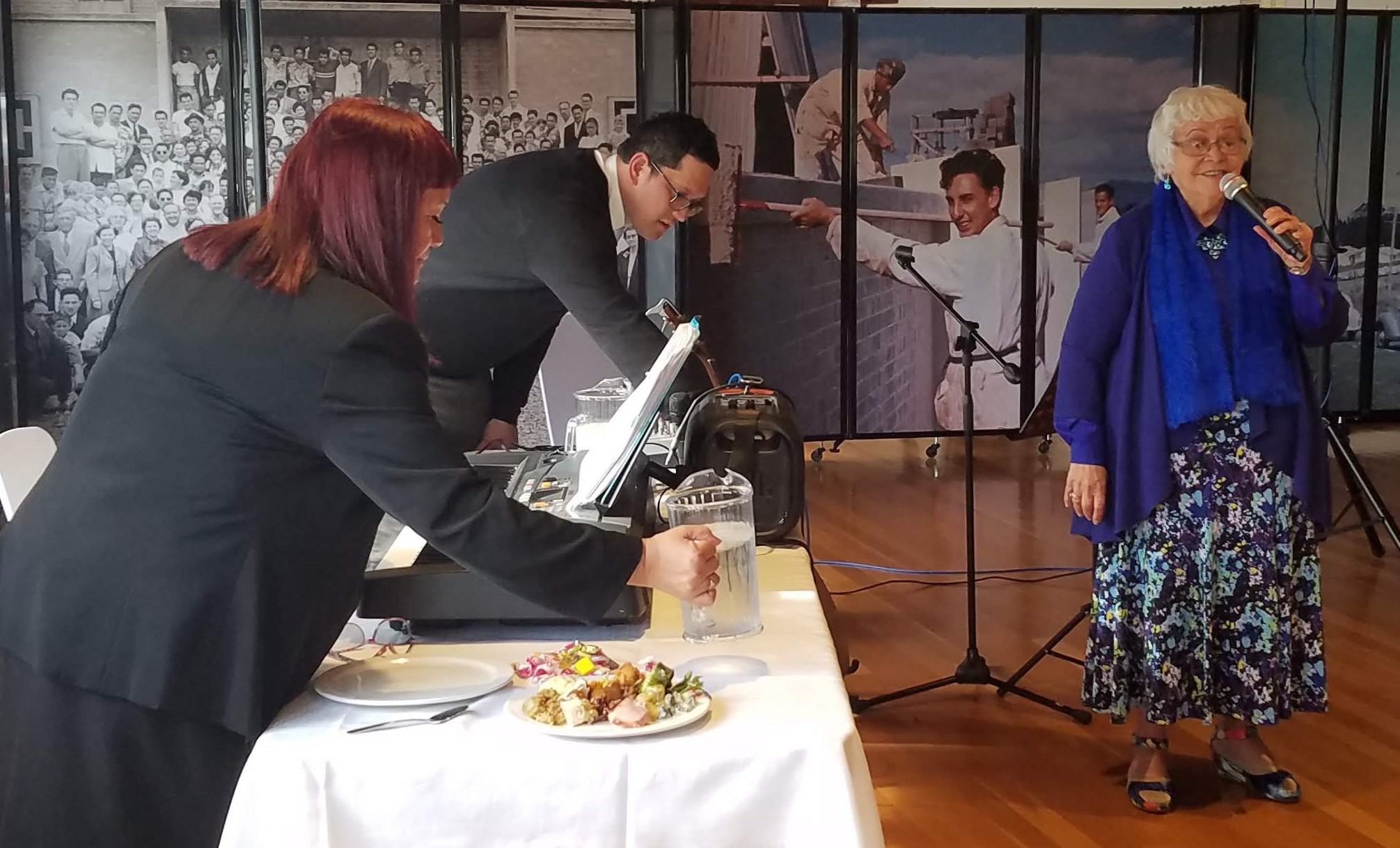
Pro musicians Soraya and Jevan take a break while Rangi sings an impromptu solo after lunch
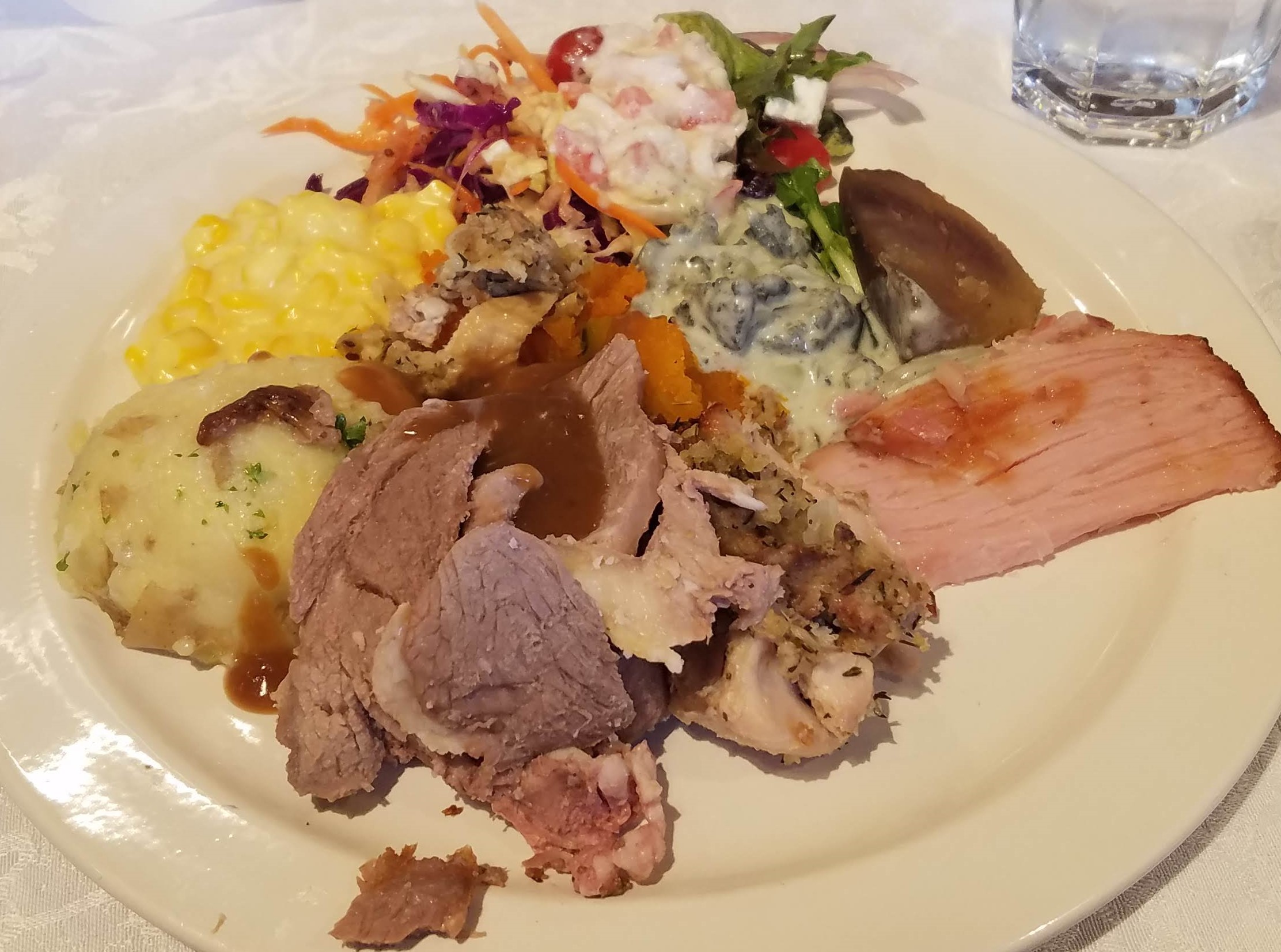
“Light lunch”
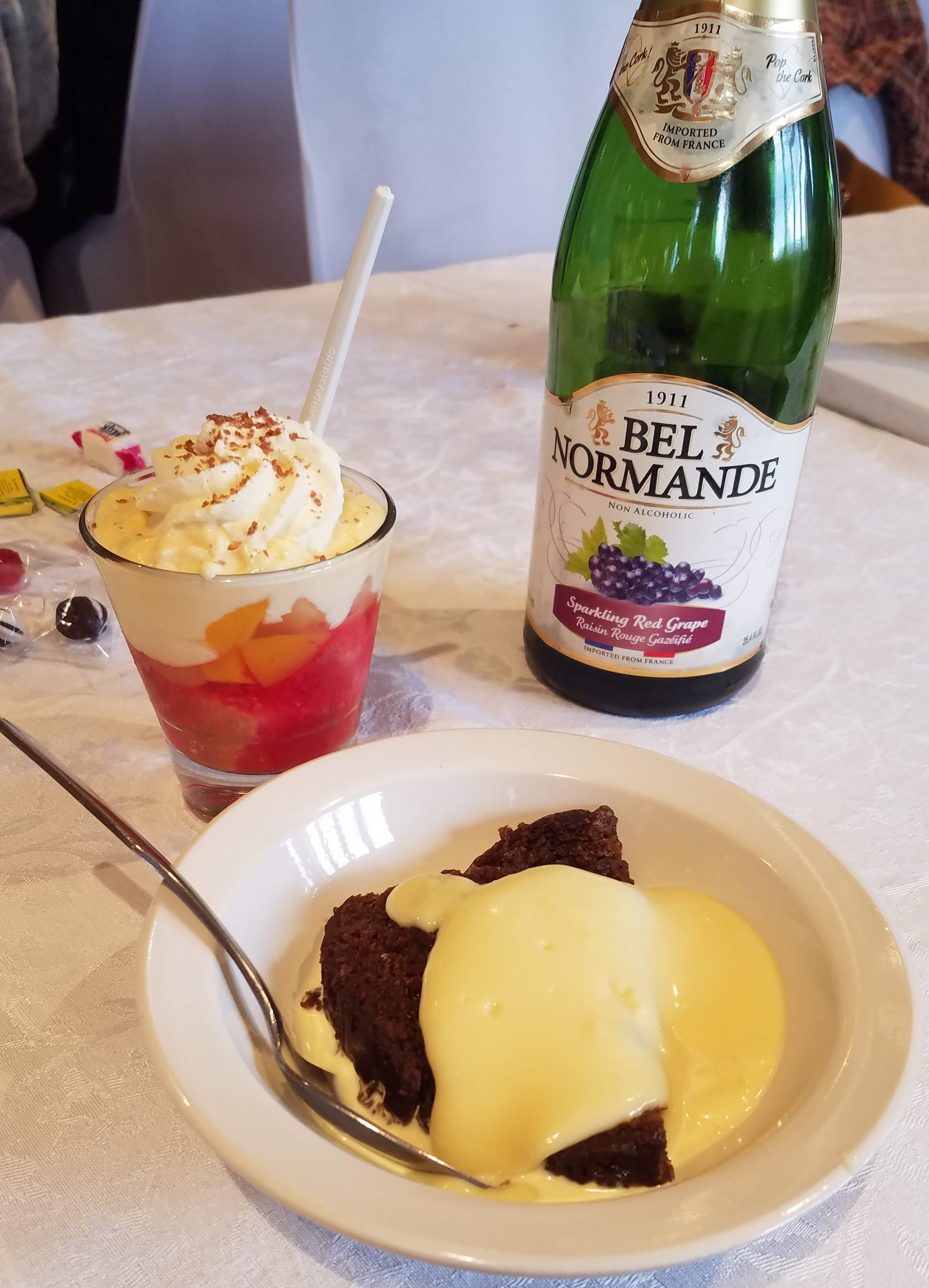
Trifle and steamed pudding with custard sauce are Kiwi favorites
After the closing prayer a long picture-taking session in front of the GRB Hall ensued, but eventually everyone made it over to the Kai Hall for the “light lunch.” The banquet hall had been decorated as elaborately as the lunch room had been for the tea, but this time there was plenty good room for all to choose their seats and sit down. An army of Relief Society sisters was in the kitchen filling plates with heaps of roast lamb, ham, kumara and pumpkin; mashed potatoes, creamed corn, fried fish, cream paua, and salad greens topped with coconut-cream ceviche. A host of polite teenagers, uniformly dressed in white shirts and black pants or skirts, delivered the plates to the seated guests, then came back to refill our water glasses. Bottles of sparkling grape juice—both red and white—stood on each table in case anyone wanted to propose a toast, and there were thick slices of rēwena bread with loads of butter on the table, too. Before long, the servers began distributing dessert. Whether you wanted it or not, everyone got a bowl of steamed pudding with custard sauce, and an individually cupped serving of trifle.
The Kai Hall was still ringing with music and lively conversation at 2:15, but the cohort from the MCPCHC could not stay to enjoy it; we had to get ready for the next event.
More Sabbath Service
Toward the end of April, Elder E informed us that Elder Y had sent a letter to him and to the presidents of the four Hamilton stakes announcing that he would speak at a youth devotional on the afternoon of Sunday 23 May, while he was in town for the opening of the Sacrifice and Consecration exhibit at the Pacific Church History Museum. He thought it was important for the rising generation to learn about the legacy of faith left by the people who built the temple—many of them ancestors of the youth of the Hamilton stakes—and what better way for them to be taught this history than by coming to see the exhibit? Thus the devotional would be held in the theatre at the Matthew Cowley Pacific Church History Centre, and following the meeting, the youth would be invited to tour the new exhibit.
“Whaaat?!” we exclaimed, aghast. “Right after the labor missionary lunch? And in our theatre? There’s no way we can fit the youth of four stakes into our theatre! What were they thinking?!”
Hori explained that he had expressed the same concern to Elder Y, who then agreed to speak to the youth of each stake separately in a rolling series of meetings held at half-hour intervals. One stake would start in the theatre at 3:00 for a 25-minute devotional, then would be dismissed to tour the exhibit while the next stake came into the theatre for their devotional at 3:30, and so forth. This plan may not have been optimal, but at least it was workable. And what could we do? Word about the devotional and exhibit tour had already gone out to the stake presidents, who thought it was a marvelous idea.
Still concerned about the potential numbers, Michael and Jo-Ena began thinking through the logistics of handling possibly 350 teenagers at the museum through the afternoon. We could divide the main stairs with a cordon with one side for “up” and the other for “down” to aid traffic flow, but that wouldn’t solve the problem of how to move the incoming group into the theatre without disturbing those already looking at displays in the gallery just outside the theatre entrance. We finally devised a plan to put the cordon at the main entrance to the Mendenhall Building so people coming in could be directed to bypass the stairs and go down a long corridor leading to the doors at the lower end of the theatre. The group just finishing their devotional could then exit into the gallery through the theatre’s upper doors, while the next group entered through the lower doors. When visitors finished touring the exhibit in the gallery, they could exit the building via the main stairs. Again, it wasn’t an optimal situation, but the plan was workable.
Then, during sacrament meeting on the Sunday just prior to the exhibit opening, the bishop of our ward announced, “There’s a new exhibit opening up at the Church History Museum next Saturday at 1:30, and then on Sunday there’s a special stake devotional at the museum at 3:30 p.m. Everyone’s invited to attend, so bring your family and come!”
Michael and Nancy exchanged alarmed glances. Nancy scribbled a note asking the bishop to clarify that the Saturday event was by invitation only and the Sunday devotional was only for youth, but although the bishop received the paper, nothing more was said over the pulpit about the museum events. In how many other wards had similar announcements been made? How many more people should we be prepared to greet at the MCPCHC the next weekend?
Only a few days before that panic-inducing moment, we had learned that due to a family emergency, Elder Y would have to cut his time in Hamilton short. He would still attend the exhibit opening and speak at all the meetings for labor missionaries, but he and his wife were now scheduled to fly out of Hamilton before the youth devotionals on Sunday afternoon.
“Whaaat?!” we exclaimed again. “Does this mean that we are now responsible for the devotional programs?”
Elder E assured us that he had spoken with the stake presidents and that each had agreed to plan a short program for his own stake. In addition, Melanie was developing an activity to help the youth interact with the Sacrifice and Consecration exhibit in a meaningful way. The only thing the MCPCHC staff needed to do for the program was show the 4-minute exhibit-preview video, and then be on hand to welcome visitors, facilitate their movement through the building, and answer their questions.
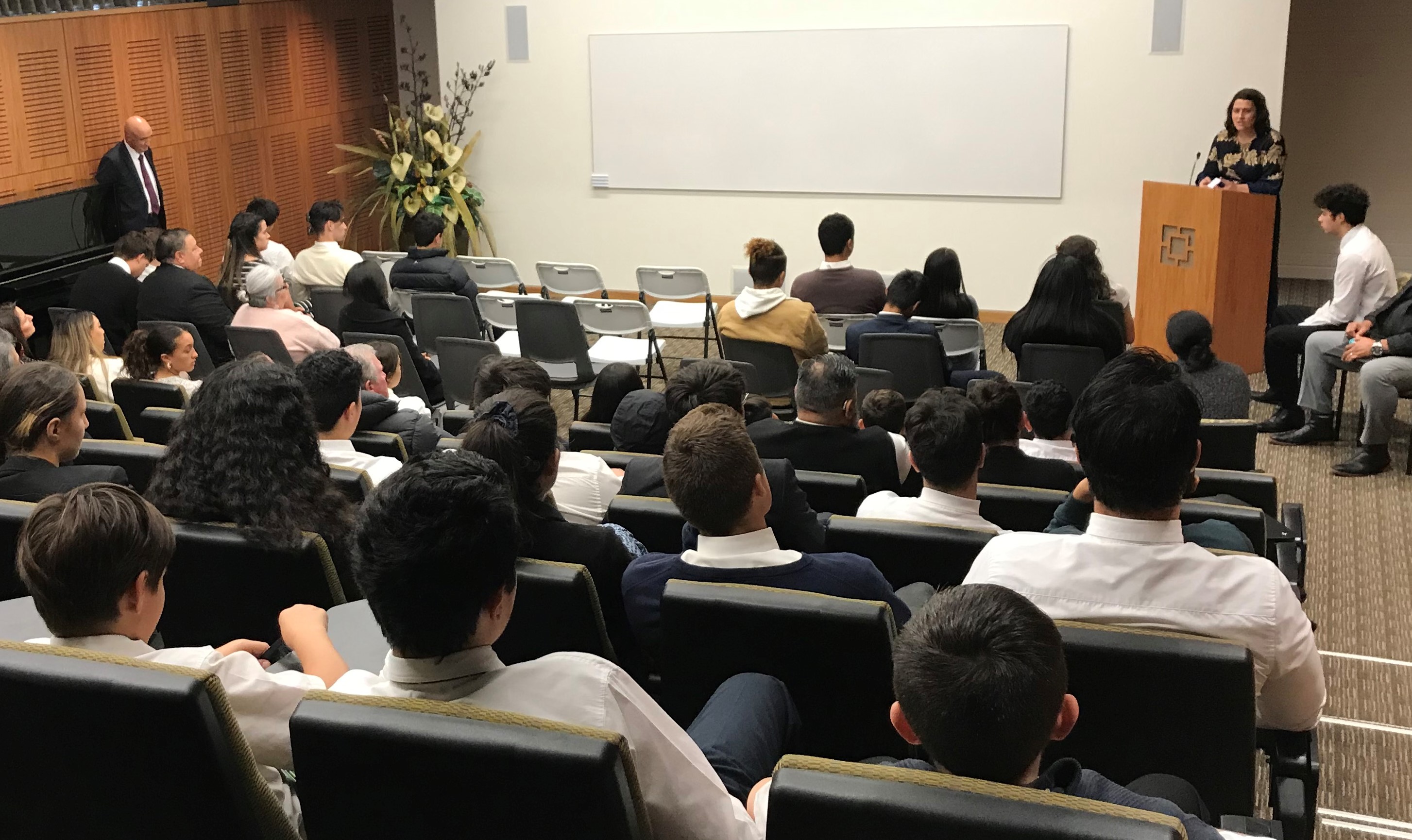
Melanie introduces an activity to help the youth learn about their heritage
So, at 2:15 on Sunday afternoon, the MCPCHC staff and several other senior missionaries who had offered to help us left the festivities in the Kai Hall and gathered in the lobby of the Mendenhall Building to receive our marching orders. Sister F and Sister W, senior trainers for the Hamilton Mission, were stationed at the main entrance to direct incoming traffic. Elder and Sister L, the Mission’s Self-Reliance specialists, led visitors through the corridors to the lower theatre entrance, where they were met by Elder and Sister G (Barry and Eva), who were monitoring what was happening inside the theatre so they could open the doors for the next group after the previous group had begun to leave. Elder and Sister E were posted in the theatre to conduct the four devotionals and ensure that each meeting ended on time. Melanie also remained in the theatre to explain the activity to each group. Michael manned the projection booth to run the video and adjust the lighting and sound as needed. Melanie’s daughter Eden was assigned to count people as they left the theatre. Diane, Wendy, Alan, and Nancy circulated through the gallery to answer questions and encourage the teens to stay focused on the exhibit.

Visitors of all ages found the exhibit and its stories from the past compelling
The activity Melanie had planned was simple but effective. Each visitor received a small card printed with the names of three individuals, families, or groups whose stories and/or photos were displayed somewhere in the exhibit. The challenge was to find at least one of the names and read the associated story, determine what that person did and why it was important, and then share a response on social media. Most of the kids eagerly accepted the challenge, and it was fun for us to observe them at first hurrying to locate the names on their cards, and then slowing down to read the stories and examine the images. Even more rewarding was seeing them make connections with the people represented in the exhibit. As Nancy was at the video kiosk, scrolling through the selection bar to show a couple of girls what interviews were available, one of them cried out, “Hey, stop there! That’s my grandpa!” The girl was attentive as she listened to him recall being awakened in the middle of the night as a child and bundled into the back of a taxi with his grandmother so they could attend the temple dedication. The taxi took them all the way from Nūhaka, a distance of over 400 km (250 miles), arriving in Hamilton in the early hours of the morning. Thomas was only five years old at the time and riding in a taxi was a new adventure, but the part of the experience that left the most indelible impression was being at the temple. “I don’t remember a lot … other than what I felt, that [the temple] was a sacred place,” he said. “These feelings remained with me as I grew into a young man. The temple was always a special place for me.”

A group of Young Women learn about the first couple from Papua New Guinea to attend the temple
We were surprised, as Barry and Eva had been when they shared stories about the construction of the temple at a devotional back in 2019, at the number of young people who said they had no idea that their own relatives had built it, or who had never heard anything about the labor missionaries at all. So many were taking selfies in front of images of their great-grandparents, uncles, and aunties, and excitedly sharing what they were learning about their heritage. (You can read more about some of these labor missionary descendants and see their photos in this news article on the exhibit opening that Jeff and Kara wrote.)
The tallying device Eden had been using to count people coming out of the theatre registered 260 after the last devotional session—indicating that we had been operating very close to capacity all afternoon. (No one from our ward came because we had explained the potential overcrowding problem to the bishop and scheduled a special evening program and tour just for them a couple of weeks later.) As the visitors began to clear out, we again assisted the Church Communications and Publishing Services crews with a few more interviews, finally packing up and heading for home about 7 p.m. We invited Jeff and Kara over to our flat for a “light supper” (scrambled eggs with guacamole and tortilla chips) and then looked forward to Monday. The museum would be closed, and we would finally get a much-needed day off.
Afterglow
As expected, Sacrifice and Consecration: The Lord Builds a People for the Temple has drawn many more visitors to the Matthew Cowley Pacific Church History Centre. On Tuesday 25 May, the first day the exhibit was open to the general public, we hosted an evening tour for the Relief Society of a local ward. The first person to arrive—early—was a tiny old woman in a big puffy coat, escorted by a much younger couple. Nancy watched as the three slowly made their way up the ramp from the carpark into the building.
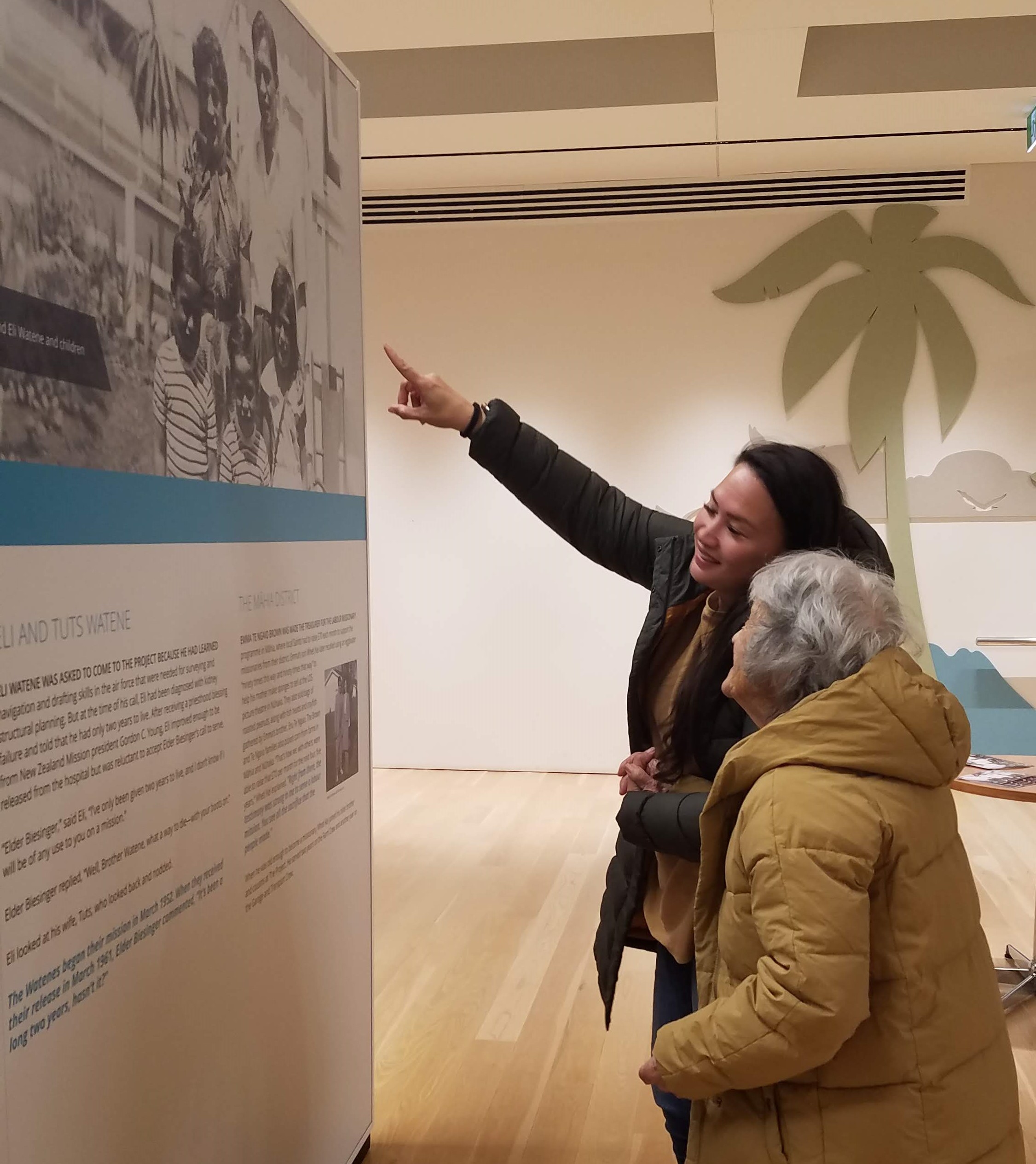
Aunty Tuts and her granddaughter enjoy a private exhibit tour
“Nana, this is the museum,” said the younger woman to the older. “We’re coming to see the new exhibit, remember? The one about the labor missionaries.” There was much tenderness in her voice. “We’re going to walk over here to the lift now, and it will take us upstairs.”
The confusion on the face of the older woman was evident. When the lift opened, the younger woman led her grandmother toward a display in The Call section of the exhibit, and pointed to the image of a family spread across the top of the wall panel. “Who’s that, Nana?” she asked.
Suddenly, Nancy recognized the older woman who tilted her head to look up at the picture. A broad smile began to spread across the woman’s wizened face, and in a delighted voice, she exclaimed, “It’s me!”
Tuts and her husband, Eli, had been among the first couples called to serve as labor missionaries. Eli’s navigation and drafting skills, learned in the military, were needed at the Church’s construction project for surveying and structural planning, but at the time of his call, Eli had been diagnosed with kidney failure and told that he had only two years to live. After receiving a priesthood blessing from the mission president, Eli improved enough to be released from the hospital, but he was reluctant to accept Elder B’s call to serve as a building missionary.
“Elder B,” Eli said, “I’ve only been given two years to live. I don’t know if I will be of any use to you.”
Elder B replied, “Well, Brother Watene, what a way to die—with your boots on.”
Eli looked at Tuts, who looked back and nodded.
Eli, Tuts, and their family moved to the construction camp in March 1952. When they were released from their labor mission in March 1961, Elder B commented, “It’s been a long two years, hasn’t it?”
Sixty years later, looking at the exhibit cleared the fog of dementia from Aunty Tuts’s mind. She recognized the face of her husband (who, miraculously, lived until 2010) and those of many other family members and old friends. Some of her great-grandchildren had been among those whose interest in learning about their heritage had been piqued as they toured the exhibition on Sunday. Aunty Tuts’s granddaughter and grandson-in-law were grateful that the exhibit had opened their children’s hearts to their ancestors, and their grandmother’s mind to happy memories. The three didn’t stay long, but coming to the museum had been a joyful experience not only for them, but for Nancy, too.
As we have welcomed visitors to the Sacrifice and Consecration exhibit and conducted special programs to help people of all ages become more engaged with it, we have witnessed the powerful effect its stories can have on minds and hearts. We’ve watched families gather around a display to take a group photo with the image of their labor missionary relative, and then spend another half hour or more sharing their own memories and expressing gratitude for the foundation of faith the temple-builders established for them. As Sister T noted in her book, “the sanctifying effect [of the construction project] on the lives of the missionaries and their posterity will remain forever” (Wendy Biesinger Thacker, More Than Bricks and Mortar: An Account of the New Zealand Labour Missionary Programme,” DMT Publishing, Salt Lake City, 2017, p. 9).
But it’s not only labor missionary descendants who are moved by the exhibit. One of our newest volunteer docents is a woman from Samoa, who spoke for many Pacific Islanders when she said, “I am so grateful to the Lord for helping the people build this temple so my family could receive the ordinances of salvation and be sealed for eternity.” We’ve heard non-LDS visitors remark, “This is an impressive story. I never really knew anything about that big white building on the hill before, but now I understand why it’s such a special place for the people here.”

Nancy with Jan, the teenage Tongan
Then there was the teenager who had been dragged to the museum by her older sister and clearly had no interest in being there—until Nancy shared with her the story of a Tongan family who made significant sacrifices to get to the temple in New Zealand. Unbeknownst to Nancy, the girl was from Tonga herself, having emigrated only a few years earlier. According to her brother-in-law, who spoke to Nancy later, she was still having trouble adjusting not only to life in a new country but also to life in her sister’s fully committed Latter-day Saint household. However, considering the hardships the Tonga family willingly endured and the little miracles that occurred so they could attend the temple completely changed the girl’s attitude. “That’s so cool!” she exclaimed after learning that people from her own homeland had been the very first couple sealed in the New Zealand Temple. The scowl she had come in with was replaced by a big smile. Before she left, she confided, “I’m supposed to share my testimony in church tomorrow, and I didn’t want to do it. But now I do, because now I have something to say.”
Another young woman took less convincing. Awestruck after spending about half an hour looking at the exhibit, she waved her arm around and said, “I’m surrounded by legends!”
We feel much the same way. The history of the New Zealand Temple deserves to be as well known among members of The Church of Jesus Christ of Latter-day Saints as the history of the Kirtland Temple or the Nauvoo Temple or the Salt Lake Temple—all built by dedicated volunteers with few resources, but tremendous faith. We are grateful to have had the opportunity to immerse ourselves in this history and then share it, and to testify along with so many people of the past that God lives, that he loves us, and that miracles will never cease.ta
I am slowly catching up on some of your posts and it was a joy to read about this wonderful project. Michael and Nancy, your combined skills have suited this mission so well, or maybe the mission has evolved to suit you? The Matthew Cowley Museum folks must be very sad to see your time coming to a close (but we can’t wait to have you back!)
Through all of the frustrations, delays, and confusions, your team of dedicated workers created a wonderful blessing for your community, both LDS and local, that shines a light on the many blessings of strong faith and commitment. Bravo to all for a successful opening!